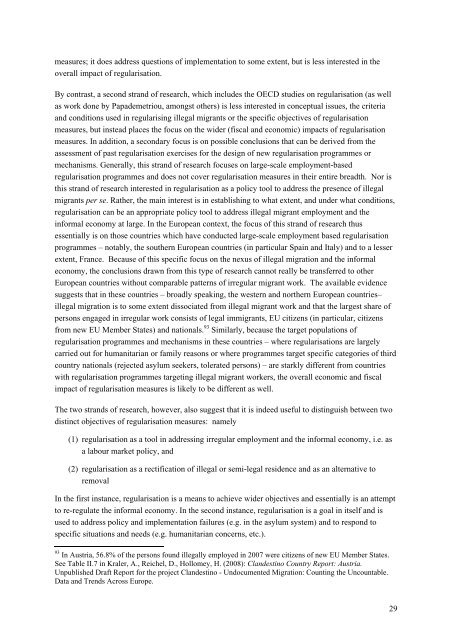REGINE Regularisations in Europe Final Report - European ...
REGINE Regularisations in Europe Final Report - European ...
REGINE Regularisations in Europe Final Report - European ...
You also want an ePaper? Increase the reach of your titles
YUMPU automatically turns print PDFs into web optimized ePapers that Google loves.
measures; it does address questions of implementation to some extent, but is less <strong>in</strong>terested <strong>in</strong> the<br />
overall impact of regularisation.<br />
By contrast, a second strand of research, which <strong>in</strong>cludes the OECD studies on regularisation (as well<br />
as work done by Papademetriou, amongst others) is less <strong>in</strong>terested <strong>in</strong> conceptual issues, the criteria<br />
and conditions used <strong>in</strong> regularis<strong>in</strong>g illegal migrants or the specific objectives of regularisation<br />
measures, but <strong>in</strong>stead places the focus on the wider (fiscal and economic) impacts of regularisation<br />
measures. In addition, a secondary focus is on possible conclusions that can be derived from the<br />
assessment of past regularisation exercises for the design of new regularisation programmes or<br />
mechanisms. Generally, this strand of research focuses on large-scale employment-based<br />
regularisation programmes and does not cover regularisation measures <strong>in</strong> their entire breadth. Nor is<br />
this strand of research <strong>in</strong>terested <strong>in</strong> regularisation as a policy tool to address the presence of illegal<br />
migrants per se. Rather, the ma<strong>in</strong> <strong>in</strong>terest is <strong>in</strong> establish<strong>in</strong>g to what extent, and under what conditions,<br />
regularisation can be an appropriate policy tool to address illegal migrant employment and the<br />
<strong>in</strong>formal economy at large. In the <strong>Europe</strong>an context, the focus of this strand of research thus<br />
essentially is on those countries which have conducted large-scale employment based regularisation<br />
programmes – notably, the southern <strong>Europe</strong>an countries (<strong>in</strong> particular Spa<strong>in</strong> and Italy) and to a lesser<br />
extent, France. Because of this specific focus on the nexus of illegal migration and the <strong>in</strong>formal<br />
economy, the conclusions drawn from this type of research cannot really be transferred to other<br />
<strong>Europe</strong>an countries without comparable patterns of irregular migrant work. The available evidence<br />
suggests that <strong>in</strong> these countries – broadly speak<strong>in</strong>g, the western and northern <strong>Europe</strong>an countries–<br />
illegal migration is to some extent dissociated from illegal migrant work and that the largest share of<br />
persons engaged <strong>in</strong> irregular work consists of legal immigrants, EU citizens (<strong>in</strong> particular, citizens<br />
from new EU Member States) and nationals. 93 Similarly, because the target populations of<br />
regularisation programmes and mechanisms <strong>in</strong> these countries – where regularisations are largely<br />
carried out for humanitarian or family reasons or where programmes target specific categories of third<br />
country nationals (rejected asylum seekers, tolerated persons) – are starkly different from countries<br />
with regularisation programmes target<strong>in</strong>g illegal migrant workers, the overall economic and fiscal<br />
impact of regularisation measures is likely to be different as well.<br />
The two strands of research, however, also suggest that it is <strong>in</strong>deed useful to dist<strong>in</strong>guish between two<br />
dist<strong>in</strong>ct objectives of regularisation measures: namely<br />
(1) regularisation as a tool <strong>in</strong> address<strong>in</strong>g irregular employment and the <strong>in</strong>formal economy, i.e. as<br />
a labour market policy, and<br />
(2) regularisation as a rectification of illegal or semi-legal residence and as an alternative to<br />
removal<br />
In the first <strong>in</strong>stance, regularisation is a means to achieve wider objectives and essentially is an attempt<br />
to re-regulate the <strong>in</strong>formal economy. In the second <strong>in</strong>stance, regularisation is a goal <strong>in</strong> itself and is<br />
used to address policy and implementation failures (e.g. <strong>in</strong> the asylum system) and to respond to<br />
specific situations and needs (e.g. humanitarian concerns, etc.).<br />
93 In Austria, 56.8% of the persons found illegally employed <strong>in</strong> 2007 were citizens of new EU Member States.<br />
See Table II.7 <strong>in</strong> Kraler, A., Reichel, D., Hollomey, H. (2008): Clandest<strong>in</strong>o Country <strong>Report</strong>: Austria.<br />
Unpublished Draft <strong>Report</strong> for the project Clandest<strong>in</strong>o - Undocumented Migration: Count<strong>in</strong>g the Uncountable.<br />
Data and Trends Across <strong>Europe</strong>.<br />
29
















